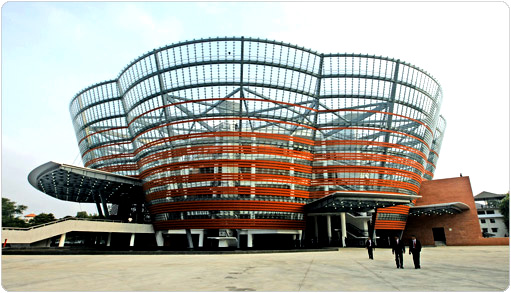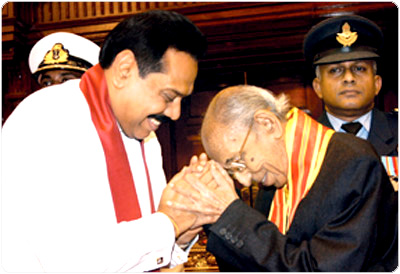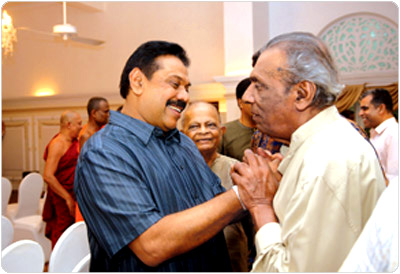|
Philosophy of the Mahinda Chinthana:
Spearheading a cultural renaissance
by Indeewara Thilakarathne and Ranga Chandrarathne
No culture can live if it attempts to be
exclusive
- Mahatma Gandhi (1869-1948)
preeminent leader of Indian nationalism.
Without culture, and the relative freedom it
implies, society, even when perfect, is but a jungle. This is why
any authentic creation is a gift to the future.
- Albert Camus (1913-1960)
French novelist, essayist and dramatist.
 Looking
back on the five years since the introduction and the implementation of
the Mahinda Chintana on arts and culture, a silent resurgence is taking
place in the spheres of arts and culture , primarily in the areas of
building infrastructure for cultural and artistic activities and the
preservation of dying indigenous art forms. The cornerstone of the
cultural policy under Mahinda Chintana is the introduction of the
National Cultural Policy (NCP) which streamlines cultural activities
initiated and implemented by institutions which come under the purview
of the Ministry of Cultural Affairs and National Heritage. Looking
back on the five years since the introduction and the implementation of
the Mahinda Chintana on arts and culture, a silent resurgence is taking
place in the spheres of arts and culture , primarily in the areas of
building infrastructure for cultural and artistic activities and the
preservation of dying indigenous art forms. The cornerstone of the
cultural policy under Mahinda Chintana is the introduction of the
National Cultural Policy (NCP) which streamlines cultural activities
initiated and implemented by institutions which come under the purview
of the Ministry of Cultural Affairs and National Heritage.
Among the primary objectives of the NCP is the promotion of cultural
diversity in a manner enhancing and strengthening a vibrant culture with
Sri Lankan identity. Over the five years, the NCP under the Mahinda
Chintana has spearheaded a silent yet an enduring cultural renaissance,
reviving the mosaic of diverse forms of arts, literature and preserving
the national heritage, which is part and parcel of the world heritage,
for posterity to reclaim the glory of the nation. What the NCP, in
essence, seeks is to promote a dynamic culture which not only
assimilates much-valued contributions from increasingly multi-ethnic and
multi-religious and pluralistic society but also the rich cultural and
artistic dividends from world culture.
It is a bi-directional and cross-fertilisation process whereby Sri
Lankan cultural products and unique art forms find their due place in
the arena of international arts and culture while making it accessible
for Sri Lankans to enjoy the high cultural products such as world
literature, films and even performing arts from diverse parts of the
globe.
|
It is a bi-directional and
cross-fertilisation process whereby Sri Lankan cultural products
and unique art forms find their due place in the arena of
international arts and culture while making it accessible for
Sri Lankans to enjoy the high cultural products such as world
literature, films and even performing arts from diverse parts of
the globe |
For instance, the Ministry of Cultural Affairs and National Heritage
has made an initiative to revive and promote ancient indigenous martial
art Angam. Among the major initiatives are the construction of the
National Performing Arts Theatre, Museum at Sigiriya, SAARC Cultural
Centre in Nawimana, Matara, Cultural Centre and Tsunami Research Centre
in Peraliya, National Arts Centre in Kundasale, Folk Music Conservation
Library at the John de Silva theatre and the Folk Art Centre.
Ten-fold policy initiative
According to the NCP, the national cultural strategy has been mapped
out on ten broader areas encompassing the plurality of cultural
activities of the nation including the introduction of the National
Cultural Policy, introducing programs aimed at promoting and preserving
traditional and indigenous art forms, developing cultural sites making
them prime touristic destinations and to herald a new era in the field
of performing arts.
One of the gigantic steps taken towards the promotion and enhancing
of Performing Arts in Sri Lanka is the construction of the National
Performing Arts Theatre in Colombo.
National Performing Arts Theatre
 The
National Performing Arts Theatre which has been constructed at the
Normads grounds in Colombo 7 with Chinese financial assistance is the
only international performing arts theatre in Sri Lanka. The
National Performing Arts Theatre which has been constructed at the
Normads grounds in Colombo 7 with Chinese financial assistance is the
only international performing arts theatre in Sri Lanka.
The architectural model of the theatre is inspired by the Nelum
Pokuna or the lotus pond in Polonnaruwa. It is a symbol of longstanding
bilateral relationship between Sri Lanka and the People’s Republic of
China.
The construction of the National Performing Arts Theatre (NPAT)
commenced in May 2008 and the total cost of the project was Rs 3,080
million. Forty percent of the total cost of the project was met with the
financial grant from the Chinese government and the rest is by the Sri
Lanka Government.
The principal objective of the project is to provide international
infrastructure with modern state-of-the–art facilities for professional
and amateur artists, researchers and foreign troops and for public
performances. The NPAT will fulfill a long-felt need for an
international facility for Performing Arts in Sri Lanka.
One of the defining traits of a culture is its folk arts. Among the
folk arts, folk music occupies a prominent position as a living
heritage. Folk music and folk songs have been virtually passed down from
generation to generation and often associated with diverse occupations
such as farming and mining.
Preserving the rich and unique legacy of folk music and folk songs is
one of the major priority areas that the government identified in its
attempts to preserve the cultural and artistic legacy of the nation.
 A
major stride taken towards that end is the establishment of the Folk
Music Conservation Library at the John de Silva Memorial Theatre. The
objective of the Folk Music Conservation Library is to preserve the rich
legacy of folk music for the posterity. A
major stride taken towards that end is the establishment of the Folk
Music Conservation Library at the John de Silva Memorial Theatre. The
objective of the Folk Music Conservation Library is to preserve the rich
legacy of folk music for the posterity.
The centre will collect material from individuals and institutions
and conserve them in digitalised form and make them available for
researchers and the public.
Among the major projects to upgrade and renovate existing theatres
are the renovation of the National Art Gallery and the John de Silva
Memorial Theatre, renovation of the Elphinstone Theatre, the Jaffna Fort
conservation project, renovation of the Rukmani Devi theatre and
acquisition and renovation of the Gampola theatre.
National Arts Centre
The National Arts Centre in Kundasale in Kandy, which is being
constructed, will provide technical, physical and intellectual
facilities for the education, dissemination and research local and
international works of arts.
The centre will also function as an exhibition centre. In addition to
the host of infrastructure development programs such as renovation of
the Tower Hall theatre and upgrading and renovation of the Cultural
Centre in Padukka, the government has introduced a series of social
security programs to ensure the welfare of artistes. Such programs
include Saraswathie Pension Scheme, Kala Devi Insurance scheme, Artistes
Insurance Scheme, Assistance to needy artistes and Funeral Assistance to
Artistes.
Inculcate moral values
Inculcating healthy values aimed at building a peaceful and highly
cultured society is one of the main objectives of the NCP under Mahinda
Chintana. The mechanism that the government has devised to inculcate
healthy values is through the setting up of Cultural Centres at
grass-roots level. Under the program, 158 Cultural Centres have been
established.
The cultural Centres, apart from functioning as a community centre,
offer classes in dancing and languages free of charge to students.
Another major program aimed at strengthening the family unit and making
a happy home is Senehasa which was held on International Women’s Day.
The program was aimed at creating a happy environment in the family.
Particularly reviving the dying tradition of bed-time storytelling and
imparting children with the knowledge of history of the land and
inculcating positive values in them, is another objective of the
program.
Promoting literature
Apart from conducting annual State Literary Festivals, a major
initiative of the Ministry is to encourage the publication of books of
lasting value. Publishing of the Mahavamsa and Mahavamsa Geetaya and
Pulathisi Vansaya is one of the milestones in this initiative.
It has been noted that there is a steady rise in the participation of
writers at the State Literary Festival since 2005. The Ministry has also
successfully conducted a series of inter-state workers’ literary
competitions with the intention of promoting literary activities among
workers and encouraging talented workers to come to the limelight.
In the sphere of archaeology, apart from existing projects, the
Department of Archaeology has taken major initiatives such as the
Wayamba Cultural Square encompassing Kurunegala, Dambadeniya, Yapahuwa
and Panduwasnuwara, Ruhunu Cultural Square.
It is obvious that over these five years, the Ministry of Cultural
Affairs and National Heritage through its Departments such as the
Department of Cultural Affairs and the Department of Archaeology has
been able to achieve broader objectives and aims enunciated in the
National Cultural Policy under the Mahinda Chintana.
The progress achieved so far was not possible without the guidance
and personal interest taken by the Secretary to the Ministry of Cultural
Affairs and National Heritage Wimal Rubasinghe and his able staff at the
Ministry.
What is important is that the resurgence of arts and culture comes at
the most propitious time when Sri Lanka is enjoying the peace dividends. |